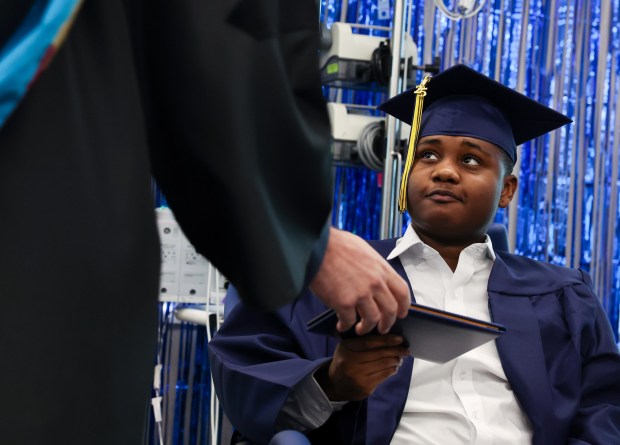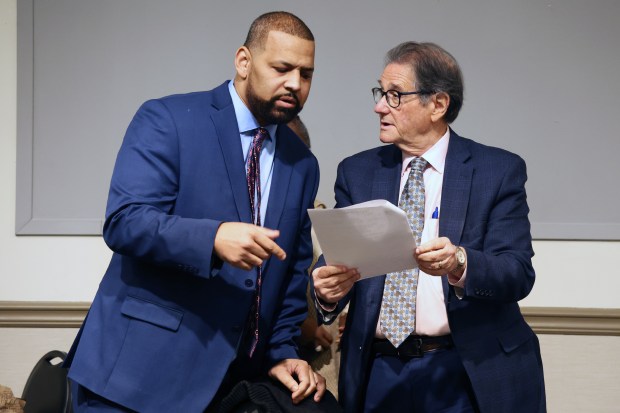Despite studying the sun for over two decades, solar astrophysicist Trae Winter didn’t experience his first total solar eclipse until 2017. Among the Nebraska cornfields, Winter and his colleagues stood in awe as the skies darkened and the world quieted. Then, they were brought back to earth when the hoots of an owl pierced the silence.
They realized that what was unfolding above was influencing the sounds around them.
“So that was, for us, very powerful,” said Winter, co-founder of a Massachusetts-based science and education lab. “That just really solidified our belief that this was something that we really wanted to do, … to put some scientific methodology on what people have been talking about and experiencing for years.”
Since then, Winter and his team have been preparing to monitor the acoustic behavior of wildlife when the next total solar eclipse sweeps over North America on April 8. While looking up, they will also keep an ear to the ground, listening as the chirping of crickets crescendos and the mooing of cows hushes.
In 2017, scientists at a South Carolina zoo reported that three-fourths of the observed mammal, bird and reptile species reacted to the eclipse. Most engaged in nighttime behavior and some expressed anxiety. This year, many scientists are again preparing to study animal behavior during the abrupt changes in light conditions. Because total solar eclipses are rare — after April 8, the next one to touch the contiguous United States will be in 2044 — they offer scientists a limited window.
Winter’s ARISA Lab is teaming up with citizens, state agencies and libraries along the path of totality to record the acoustic activity of animals and insects when the moon completely covers the sun.
The NASA-funded project also aims to increase the scientific participation of everyday citizens and people with vision loss. Ahead of April’s big event, the researchers have distributed hundreds of acoustic monitoring devices to collaborators across 15 states, including Illinois.
“They can’t do all the research or all the data collection, they can only put it all together,” said Theresa Madel, a Murphysboro resident who has previously participated in nature studies and is one of the citizen scientists who will help the researchers by installing audio recorders downstate. “So, to be part of something that’s bigger than me and be able to contribute to that has just been very exciting.”
She is working with Southern Illinois University in Carbondale, which is one of the few spots in the United States that was in the path of totality, or moon’s shadow, in 2017 and will be again in 2024. The university will play a crucial role in collecting data for the project, called Eclipse Soundscapes. Carbondale will be in totality for over 4 minutes.
Brent Pease, an assistant professor of forestry at SIU whose Sounds of Nature lab studies biodiversity through sound, has contributed over 100 sound recorders and helped enlist hundreds of local volunteers such as Madel.
During the 2017 total eclipse, the Natural Sounds and Night Skies Division of the National Parks Service conducted a smaller study with 29 recording devices across 14 parks that found insect and animal sounds decreased during the eclipse in some locations while increasing in others.
“It was (with) far more expensive, scientific equipment that really required people who are knowledgeable in its use,” Winter said. “That is kind of what we’re building off of, and we’re trying to do more with it.”
By asking citizens in the path of totality to join in the research with simpler, more affordable devices, scientists hope to expand their data pool. And participants’ local knowledge will also be instrumental in determining the best monitoring sites. Madel said after participating in Pease’s Sounds of Nature lab for the last two years, she knows good locations, from her backyard to Snake Road in Shawnee National Forest.
“Actually engaging the public and doing it in a way that’s accessible, inclusive, leads to better science at the end as well,” Winter said.
Data collectors for the project will head outdoors to place their audio recording devices two days before the eclipse, wrapping them in waterproof plastic, putting them in a camouflage bag and zip-tying them to tree trunks a few feet off the ground. They will then retrieve the recorders two days after the eclipse, having gathered data for five days.
“They’re dialed in on data collection, they’re excited to participate. They know that (citizen) science is real science, they know that we use our data to make real-world conclusions,” Pease said. “They care about nature. They care about biodiversity … and they want to try to play a small role in helping understand, study, conserve or preserve (it).”
Madel said she spent two afternoons checking out different spots before deciding where she will place the device in April.
“It’s amazing how many things are making noise that you don’t even realize are making noise. And when I set (the devices) up, I always stop for a minute and go, ‘Oh, OK, they’re going to be able to hear traffic on that one. Maybe I should do it a little bit farther this way,’” she said. “I finally found this (spot) basically traipsing through the woods. … It’s kind of part of the adventure.”
Acoustic observations
Ahead of an Aug. 31, 1932, total solar eclipse that would be visible from parts of Vermont, New Hampshire, Maine and Massachusetts, entomologist and Harvard professor William Morton Wheeler put out newspaper ads asking New England residents to write down their observations of nature during the event.
“Back in those days, they didn’t have the same equipment that we do; they didn’t have the internet, so it was very different,” Winter said. “What they found (was) that people reported all these multisensory observations of the eclipse, so not only what they saw, but the changes in the noises that bees made, how different birds reacted, both in their movement but also in their calls.”
These sounds can contain a wealth of information, as evidenced by the field of acoustic ecology, which is the study of organisms and their relationships to each other and the environment through sound.
Madel doesn’t remember paying attention to sounds during the 2017 eclipse. She said she was so intent on looking up at the blacked-out sun during what she thought at the time would be a unique lifetime experience. But she is getting the rare opportunity to see — and now, listen to — another total eclipse from her home less than a decade later.
“I think I will be very attuned to the noise part of it,” she said. “This year, I’m going to notice things like that, the birds and the butterflies and the insects.”
Participating in the Sounds of Nature lab piqued Madel’s curiosity about her natural surroundings. She has since started monitoring butterflies, damselflies and dragonflies, and contributing to bird counts. Her granddaughter recently informed her she wants to tag along during her trail walks to spot the flying insects.
“Being part of citizen science is just such a humbling experience,” Madel said. “There’s so much going on in the world and you are like, ‘How can make a difference?’ And here’s this little thing you can do that doesn’t take a lot of time.”
Engaging more pathways
Since its inception, another big goal of the project has been to allow people with vision loss to take part in the celestial phenomenon.
The researchers say having included visually impaired people in the planning and development of this citizen-led acoustic ecology study has led to the development of tools that will enhance the multisensory experience of fully sighted participants during the eclipse.
“Every sense has a different pathway to your brain, to your memories. The more of those pathways that you engage, the deeper the experience,” Winter said. “So we’re not just making something so that people who are blind or have low vision can also participate. We’re making something so that everybody participating actually has a deeper and more meaningful experience.”
For instance, bump dots that label the different parts of the acoustic monitors will let users feel their way around the device without looking at it so they are not fumbling during the event.
“The beauty of it is they’re creating an experience that addresses alternative means of accessing that information,” said Anil Lewis, executive director for blindness initiatives at the federation. “You’re creating tools that are better used by everyone.”
The project is part of larger efforts to increase accessibility, both for people with disabilities and for the general public, to disciplines such as science, technology, engineering, art and math.
“This is an event that people with no background, any sort of scientific training or education can celebrate and marvel in. This is a period of people just being excited about this event that’s happening to us that we happen to be here for,” Pease said. “We get one shot at this. … So this is our time to bask in it, to learn from it.”
At Harvard, a group of astronomers led by Allyson Bieryla has been running workshops through the LightSound project to build boxes that can convert light data from an eclipse into sounds and distribute them to people with limited or total vision loss so they can participate in the moment.
A map of over 17,000 LightSound devices all over the country for public and private use can be found at astrolab.fas.harvard.edu/LightSound.html.
A cosmic coincidence
While the time to sign up to receive a data collection kit from Eclipse Soundscapes has passed, aspiring citizen scientists can still get involved and contribute to the acoustic ecology project in a variety of ways listed at eclipsesoundscapes.org/roles.
Like Wheeler’s trusty crew of volunteer observers in 1932, which included the general public, naturalists and wildlife officers from all over New England, this year’s eclipse viewers on and off the path of totality can also gather invaluable data by simply paying attention to the surrounding noises.
“That observer role is essentially just being mindful during the eclipse, slowing down and just (noticing) how you perceive the changes around you during the eclipse, and reporting that,” Winter said.
A few months after the eclipse, in the summer, the public will be able to stay engaged with Eclipse Soundscapes by helping scientists analyze information from the recordings and make sense of any patterns.
“We’re trying to preserve everything, so that 20 years from now, researchers can use our data and see how their recordings are different,” Winter said. “This is very much a cosmic coincidence that allows us to have these eclipses. … So we’re in the right place at the right time.”




